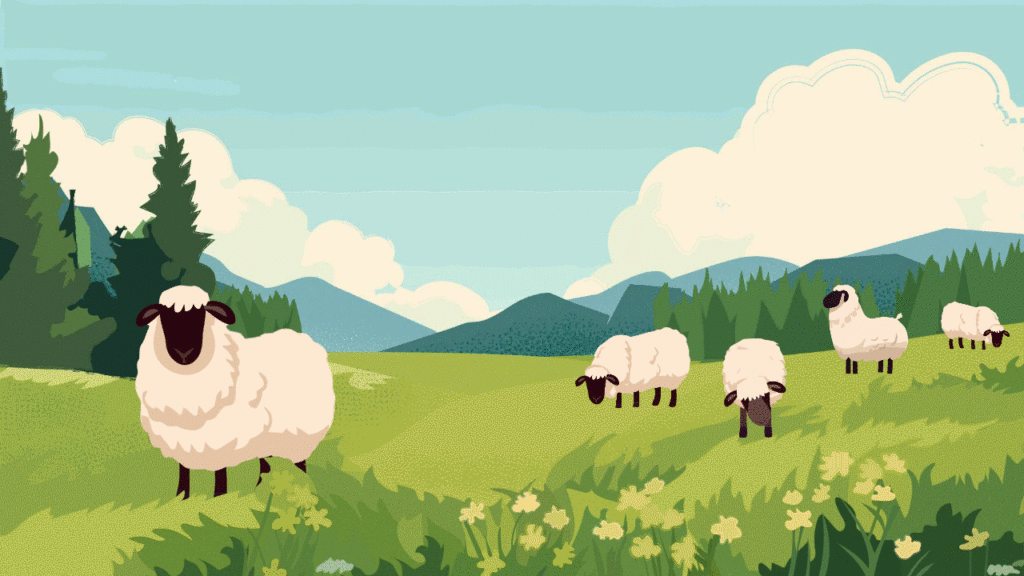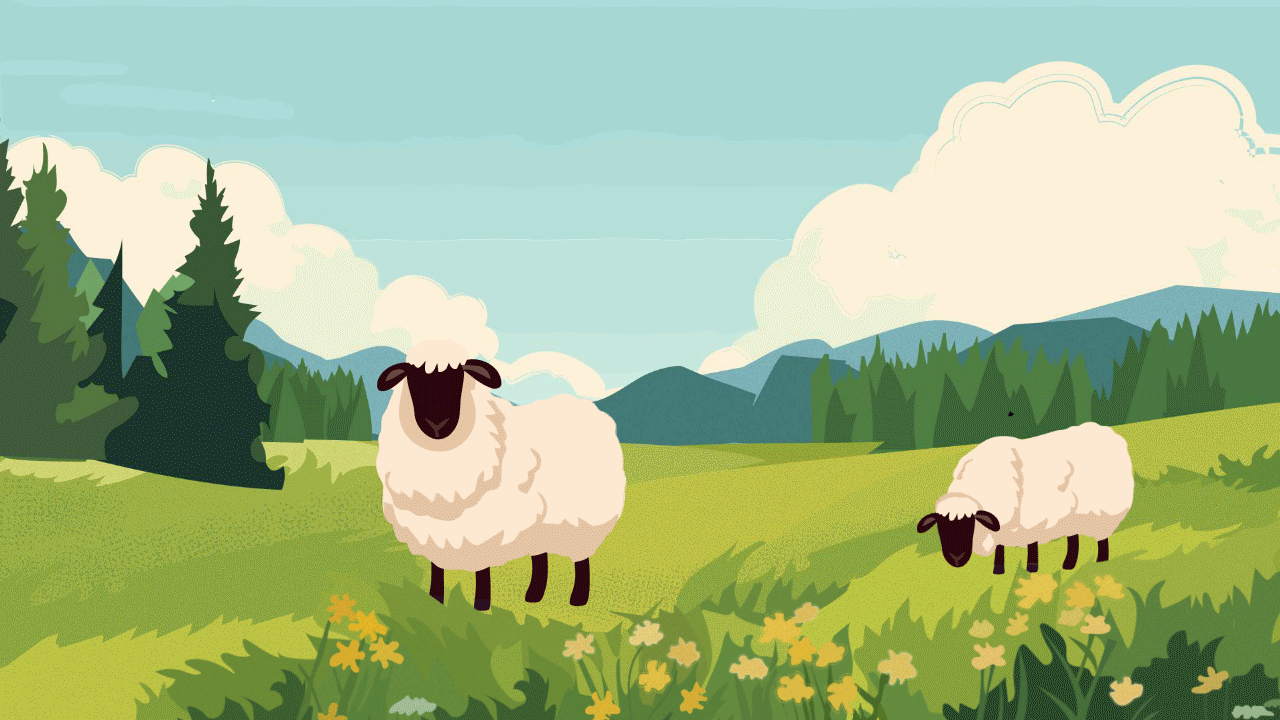This is part 4 of 5 in my sheep loops.
Sheep Animation Updates
Here is my final First Loop. I added the shepherd.
Here is my last loop as well.
Only the 4th loop is left.
Sheep Animation Loop 3
Sheep Animation Loop 2
Here are 2 variations of the 2nd loop so far. The first one, I forgot it was supposed to loop. I tried fixing it with the second video. There are still some tweaks to make – the clouds aren’t perfect at times. Technically it isn’t a perfect loop.
One challenge I’m facing is I only have 72 frames to work with and I need to show drastically changing landscape. I’m not sure I like how fast the sheep is moving in the second animation but I’m struggling to find a way around it. Any thoughts?
Animation Experiment 2

This is my second rendition of animating my sheep. I added more sheep, texturized the elements, and added movement to the flowers. My export settings washed out the color on the flowers, unfortunately. For my next version, I’ll have to fix that, add a shepherd, and smooth out the movements. What do you think? Any suggestions?
Animation Experiment
First week of animation experimentation.

I got a little lazy with the feet walking and the environment. For future versions, I want the flowers to wave gently. I used Adobe Animate for the first time to create this gif. The animation elements are partial vectors from Adobe Stock. I imported them into Figma to assemble and add texture. For the final animation, I plan on adding more texture and brushstrokes.
Here are the files I used and tweaked:



Wallstreet Warriors Documentation
Atlas Arcade Final Documentation
Game Podcast: Dot’s Home
by Evelyn, Colin, and Tori
Game Design 2 Class Game Test
What was the most frustrating aspect? Not understanding how my game multipliers affected my score.
What was your favorite moment? Playtesting ( I really like Hues n Cues)
Was there anything you wanted to do? Maybe points for perceived time invested in game prototypes. I’ve played prototypes that have a huge amount of thought, time, and resources invested. This might already exist.
If I had a magic wand to change, add or remove? Maybe differentiation from Game Design 1. It feels very similar in layout in lectures, projects, and outcome and not sure how much additional information I gained from an educational perspective.
If this game scoring is kept for future classes, it would be cool to have the score on a website. It could show what multipliers you have and how it effects your score.
What should be improved? I feel like the complexity of certain games versus others isn’t taken into consideration with the final prototype scoring system. I could be wrong, but it seems like a simple card game and a very complex coded game would get the same score. The way it’s currently set up, I feel like it’s encouraging producing quick, easy games. Specifically for a games for change class, it becomes harder to produce impactful, polished, or researched games.
Game Message? Iteration is king. You must test your ideas, get feedback, and provide feedback.
Game in 3 words? experimental, creative, prototypes
Dot’s Home Game Review
What was the most frustrating aspect? The players had very few choices. There was little guidance or motivation to finish.
What was your favorite moment? Finding the wallet. it was a moment where the user actually can interact with elements of the game. you could move parts of the wallet around to see family pictures.
Was there anything you wanted to do? I really wanted to do more things in this game. It really was just a click through choose your own story game. I wanted puzzles or more interactive elements of consequence.
If I had a magic wand to change, add or remove? More interactions. Perhaps elements that will help enhance the time you travel back to? When traveling to the 1950s, it would be nice if there was a radio that would play music from the time period. There was a street that players could walk down but there wasn’t really anything to interact with.
What should be improved? More interactions as said. I think it would attract more people to play the game.
Game Message? 1. Individual choices could effect your family for generations. 2. Effects of race on the real estate market since thee 1950s.
Game in 3 words? real-estate, racial awareness, family heritage
Cry Me a Pond Playtest Notes
What was the most frustrating aspect? Maybe not wanting/ not thinking about an answer to the card
What was your favorite moment? I like the calming color scheme. The discussion brought out aspects of other people you didn’t expect. The social aspect of this game was fun.
Was there anything you wanted to do? Maybe keep going… The board ends but what if people haven’t reached happiness? Could it be a circular pond?
If I had a magic wand to change, add or remove? Maybe labeling the colored lily pads? Which one is sad and which one is happy.
What should be improved? Board shape/ length of lily pad path – it stopped too abruptedly. Also, no vengeful water spirit cards were chosen… I wanted to interact more with that but then I also question if it contradicts your game’s message? Is the purpose of the game to talk through/solve problems leading to peace? because school questions don’t do that. I guess what I’m getting at is what is the purpose of the Ames Card’s in this game’s larger message.
Game Message? Venting, collaboration, and mutual support lead to social and mental benefits.
Game in 3 words? Empathy, conversation-based, social-health, deep, bonding
Other questions: If taken further, it would be helpful to add more clarity in the rules. how long does it take? Player range? Pieces?
Butterfly Effect Game Test
Most frustrating aspect? I thought the spaces + dice combo was annoying. I felt like I was making progress so slowly. the number of spaces between each butterfly was always one more than the max (3). I felt like it added a sense of predictability: you roll, next turn you get a butterfly, you roll, next turn you get to a butterfly.
Most fun aspect? Answering the question cards
anything you wanted to do but couldn’t? I wish there weren’t card repeats. It makes it less interesting. Oftentimes, when someone reads a card, the group discusses it.
If I had a magic wand to change, add or remove? People shouldn’t begin by choosing to go left or right (people who go left will never win). There should be a couple spaces straight before the first butterfly choice which then directs them left or right.
What should be improved? the card and the boards. Butterfly player pieces would be cute.
Game’s message? to live cleaner and work towards a better world
Game in 3 words? persuasive, revealing, purposeful
Hues n Cues Playtest
What was the most frustrating aspect? People being colorblind
Favorite Moment of the game? People being color blind AND funny, creative, or unhinged descriptions of colors.
was there anything i wanted to do and couldn’t? I really enjoy this game the way it is!
If I had a magic wand to change, add, or remove anything? I think the colors on the card should match the board. I think they also could be more creative with the card designs – what if they were more inspired by pantone swatches? Also, I would’ve liked perhaps a different shape of marker?
Improved for next version? I think this game is functional and fun without any changes! However, I would enjoy the design changes as stated above.
Games message? Training for working at crayola
Game in 3 words? Art-nerd, Group, Creative
Around the World in 80 Days – Prototype 2 Playtest
Changes from GameTest 1 to 2
- Group vote for mispronunciation
- harder phrases to learn
- shorter timer to memorize timer
- Incentive to read culture cards? People aren’t reading
- Changed the end of the game from reaching 10 culture cards to returning back to home.
- Added 3x more phrases, trivia, and group cards.
- Added multi choice
Playtest 2 notes: 9 people played
Changes I will make for the next prototype:
I need to LABEL CULTURE CARDS
Change trivia card format – Put answer on the back of the card.
Tweak the group game mechanics. People can drop out of remembering a country. If players pass, pass until the next player knows them. If you pass, you are out. Also, if players challenge a country stated in this mini game, the player who landed on the space can google it.
North Korea is not on the Group Cards for “n”
Greenland is technically not a country… but everybody thinks its a country. Perhaps add a loophole that if majority thinks a “territory” is considered a country, it can count. This is only relevant if players challenge a country within the Group Game
Add back an alternative ending – now, to win, it’s the first player to 7 culture cards or when a player gets back to start.
Maybe add trivia cards for how to say a country’s name in their native language
I will add a player cap of 8

